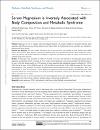Serum Magnesium is Inversely Associated with Body Composition and Metabolic Syndrome
| Author | Al Shammaa, Almaha |
| Author | Al-Thani, Amna |
| Author | Al-Kaabi, Maryam |
| Author | Al-Saeed, Kaltham |
| Author | Alanazi, Maria |
| Author | Shi, Zumin |
| Available date | 2023-05-25T07:15:48Z |
| Publication Date | 2023-01-12 |
| Publication Name | Diabetes, Metabolic Syndrome and Obesity |
| Identifier | http://dx.doi.org/10.2147/DMSO.S391369 |
| Citation | Al Shammaa, A., Al-Thani, A., Al-Kaabi, M., Al-Saeed, K., Alanazi, M., & Shi, Z. (2023). Serum Magnesium is Inversely Associated with Body Composition and Metabolic Syndrome. Diabetes, Metabolic Syndrome and Obesity, 95-104. |
| ISSN | 1178-7007 |
| Abstract | Purpose: Magnesium is vital to maintain normal physiological functions. We aimed to identify the association between serum magnesium and different measures of body adiposity among Qatari adults. We hypothesized that the association was mediated by depression and sleep duration. Patients and Methods: The study included 1000 adults aged 20 years and above who attended the Qatar Biobank Study (QBB) between 2012 and 2019. Body adiposity was assessed using dual-energy X-ray absorptiometry (DEXA). Serum magnesium concentration was measured. Sub-optimal magnesium was defined as magnesium concentration less than 0.85 mmol/L. The association was examined using linear regression. Results: The mean age of the participants (n=1000) was 35.8 (SD 10.3) years. More than half of the participants had sub-optimal magnesium concentrations (60.2% in men and 52.3% in women). Serum magnesium was inversely associated with different types of fat mass. In the fully adjusted model, per 1 SD increment of serum magnesium had standardized regression coefficients of −0.09 (p 0.005) for total fat mass, −0.08 (p 0.008) for trunk fat, −0.09 (p 0.003) for gynoid fat and −0.08 (p 0.008) for android fat. There was no gender difference in the association. The inverse association between serum magnesium and fat mass was significant in those with sleep duration ≥7 hours but not in those <7 hours. Depressive symptom and sleep did not mediate the association between serum magnesium and fat mass. Serum magnesium was inversely associated with metabolic syndrome (per 1 SD increment had an odds ratio (OR) of 0.70 (95% CI 0.57–0.85)). Conclusion: There was an inverse association between serum magnesium and fat mass, especially among those with an adequate sleep duration and without chronic conditions including diabetes, hypertension and depression. |
| Sponsor | This research was supported by a grant from Qatar University (Grant No: QUST-1-CHS-2022-348). The publication of this article was funded by the Qatar National Library. |
| Language | en |
| Publisher | Dove Medical Press |
| Subject | body adiposity cross-sectional study DEXA Qatar Biobank serum magnesium total fat mass |
| Type | Article |
| Pagination | 95-104 |
| Volume Number | 16 |
Files in this item
This item appears in the following Collection(s)
-
Human Nutrition [457 items ]


